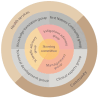Adapting the Grog survey app for alcohol screening and feedback in aboriginal and Torres Strait Islander health services: a mixed methods study protocol
- PMID: 40898313
- PMCID: PMC12403270
- DOI: 10.1186/s13722-025-00602-w
Adapting the Grog survey app for alcohol screening and feedback in aboriginal and Torres Strait Islander health services: a mixed methods study protocol
Abstract
Background: Routine use of brief, structured screening tools is essential to detect and provide support for Australians who drink above recommended levels. However, detecting drinking above recommended levels in Aboriginal and Torres Strait Islander Australian primary care settings is complex. Inaccuracies in completing a screening tool such as Alcohol Use Disorders Identification Test - Consumption, can lead to errors in estimating drinking in First Nations contexts where group sharing and episodic drinking make it difficult to accurately estimate alcohol consumption with tools that assume regular drinking patterns. This can lead to under-detection of drinking and a mismatch with the subsequent care that is offered. Hence, screening tools that consider these contextual factors are needed to make it easier for First Nations Australian primary care services to screen for alcohol consumption above recommended levels. Electronic screening tools offer the technical flexibility to consider the drinking contexts Furthermore, for sensitive topics such as alcohol and other drugs, computer-based screening in the general population has been shown to provide more accurate and comprehensive responses compared with face-to-face interviews.
Aim: To facilitate alcohol screening and brief intervention in First Nations Australian primary care settings by adapting the Grog App - a community survey tool validated in Aboriginal and Torres Strait Islander populations for use in primary care.
Methods: The project will use mixed-methods techniques across five study stages: 1 - Interest-holder consultation; 2 - technical development; 3 - re-validation and user interface acceptability; 4 - implementation in an Aboriginal and Torres Strait Islander primary care setting; 5 - acceptability study, six months after implementation.
Discussion: The project will produce a novel, culturally appropriate digital health tool and implementation resources to make it easier to conduct routine alcohol screening in primary care contexts for a priority population, which may lead to increased screening and alcohol care rates. It will also provide first-ever contextual data about implementation of new health service improvement strategy focused on an electronic alcohol consumption screening tool, which is lacking in peer-reviewed literature. This study will also provide an important evidence base for using continuous quality improvement as an implementation approach in primary care settings.
Keywords: Aboriginal and torres strait islander; Alcohol; Brief interventions; Continuous quality improvement; Electronic screening; First nations; Implementation; Primary care.
© 2025. The Author(s).
Conflict of interest statement
Declarations. Ethics approval and consent to participate: This study received ethics approval from the Aboriginal Health and Medical Research Council of New South Wales (NSW; approval no. 2076/23), and Metro South Health, Queensland Human Research Ethics Committee (Qld, approval No. REC/2023/QMS/100707, REC/2023/QMS/100707). Consent for publication: Not applicable. Competing interests: The authors declare no competing interests.
Figures
References
-
- O’Connor EA, Perdue LA, Senger CA, Rushkin M, Patnode CD, Bean SI, et al. Screening and behavioral counseling interventions to reduce unhealthy alcohol use in adolescents and adults: updated evidence report and systematic review for the US preventive services task force. JAMA. 2018;320(18):1910–28. - PubMed
-
- Brady M, Sibthorpe B, Bailie R, Ball S, Sumnerdodd P. The feasibility and acceptability of introducing brief intervention for alcohol misuse in an urban aboriginal medical service. Drug Alcohol Rev. 2002;21(4):375–80. - PubMed
MeSH terms
Grants and funding
- MRF2021660/Department of Health and Aged Care, Australian Government
- MRF2021660/Department of Health and Aged Care, Australian Government
- MRF2021660/Department of Health and Aged Care, Australian Government
- MRF2021660/Department of Health and Aged Care, Australian Government
- MRF2021660/Department of Health and Aged Care, Australian Government
- MRF2021660/Department of Health and Aged Care, Australian Government
- MRF2021660/Department of Health and Aged Care, Australian Government
- MRF2021660/Department of Health and Aged Care, Australian Government
- MRF2021660/Department of Health and Aged Care, Australian Government
- MRF2021660/Department of Health and Aged Care, Australian Government
- MRF2021660/Department of Health and Aged Care, Australian Government
LinkOut - more resources
Full Text Sources
Medical



